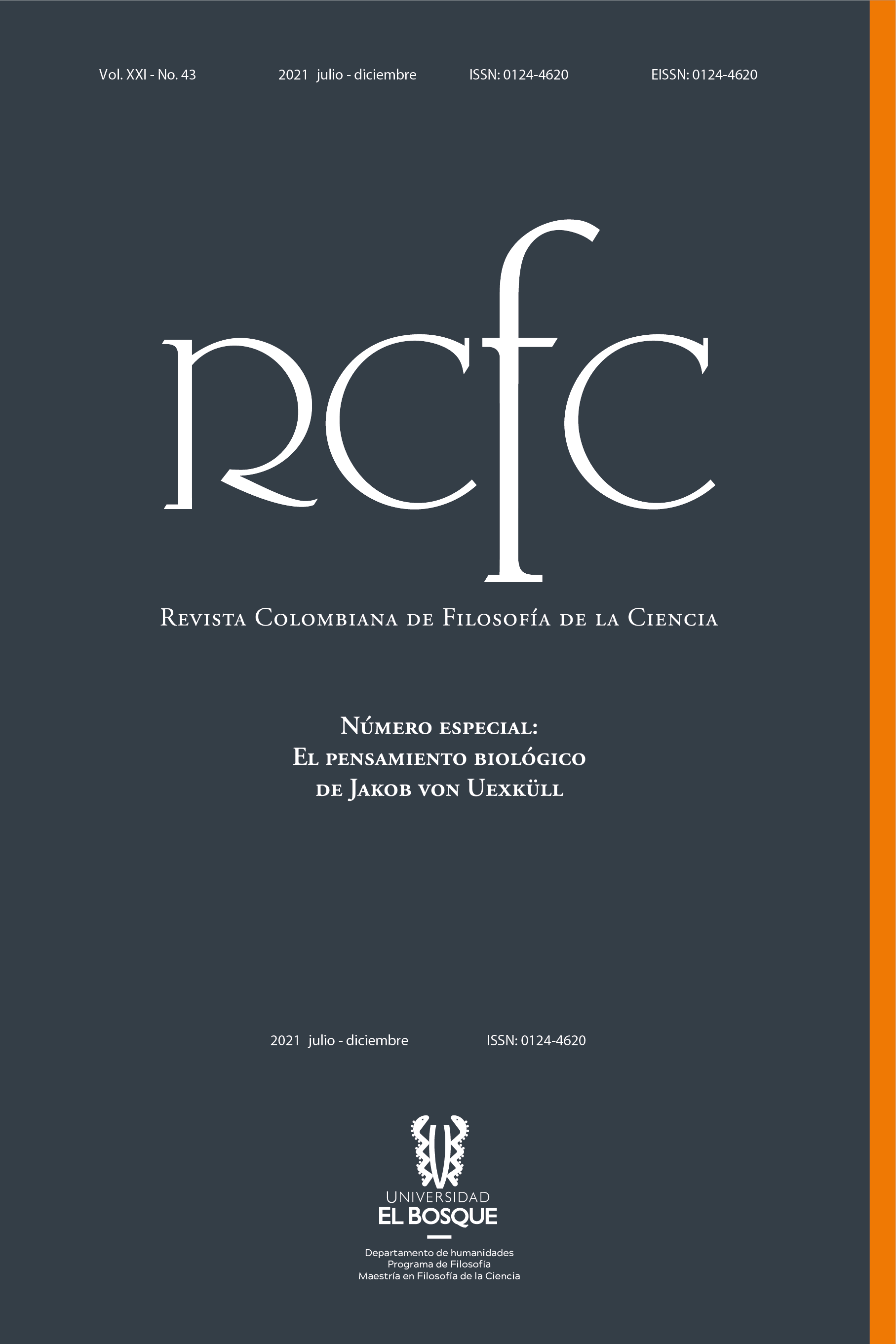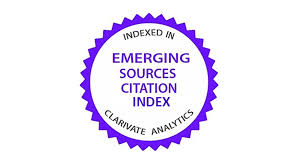Zoosemiótica para Principiantes: del Umwelt de Uexküll a las Fronteras Zoosemióticas del Siglo XXI
DOI:
https://doi.org/10.18270/rcfc.v43i21.3458Palabras clave:
biosemiótica, zoosemiótica, teoría del significado de Uexküll, biohermenéutica, biología cognitiva, órgano semántico, selección semióticaResumen
El propósito de este artículo es introducir al lector al estudio de la zoosemiótica. Para esto, primero se ejemplifica la inconsistencia del pensamiento neodarwiniano al estudiar la comunicación animal. Posteriormente, se muestra un análisis recopilatorio de las principales herramientas conceptuales y autores, que contribuyeron a la formación de la zoosemiótica. Luego se señalan sus principales contribuciones conceptuales al estudio de la evolución: homosemiosis, mimetismo y oxímoron morfológico. Por último, se resumen los métodos y herramientas que se utilizan actualmente para investigar en zoosemiótica, y se señala cuáles son los fenómenos que más recientemente representan un reto para esta disciplina.
Descargas
Referencias bibliográficas
Barbieri, Marcello. “Biosemiotics: a New Understanding of Life”. Naturwissenschaften 95.7 (2008): 577-599. <https://doi.org/10.1007/s00114-008-0368-x>
Baer, Eugen. “Thomas A. Sebeok’s Doctrine of Signs”. Classics of Semiotics. Eds. Martin Krampen, et ál. Boston MA: Springer, 1987. 181-210. <https://www.doi.org/10.1007/978-1-4757-9700-8_8>
Blough, Donald S. “The Perception of Similarity”. Ed. Cook, Robert G. Avian Visual Cognition, 2001. 23-25. Online <http://www.pigeon.psy.tufts.edu/avc/dblough/>
Campbell, Bernard. Ed. Sexual selection and the descent of man, 1871-1971. Chicago: Aldine Publishing Company, 1972.
Campbell, Cary., Olteanu, Alin., y Kull, Kalevi. “Learning and Knowing as Semiosis: Extending the Conceptual Apparatus of Semiotics”. Sign Systems Studies 47.3/4. (2019): 352-381.
Castro, Oscar. Jakob von Uexküll: El concepto de Umwelt y el origen de la biosemiótica. Barcelona, España: UAB, 2009.
Dalziell, Anastasia H., y Welbergen, Justin A. “Mimicry for all Modalities”. Ecology Letters 19.6 (2016): 609-619. <https://doi.org/10.1111/ele.12602>
Delahaye, Pauline. “Building Zoosemiotics”. A Semiotic Methodology for Animal Studies 19. Cham, Switzerland: Springer Nature, 2019. 183-195. <https://doi.org/10.1007/978-3-030-28813-6_8>
Ghiselin, Michel T. “Homology as a Relation of Correspondence between Parts of Individuals”. Theory in Biosciences 124.2 (2005): 91-103. <https://doi.org/10.1007/BF02814478>
Gould, Stephen Jay. The Structure of Evolutionary Theory. Massachusetts: Harvard University Press, 2002.
Gould, Stephen Jay., & Vrba, Elisabeth S. “Exaptation-a Missing Term in the Science of Form”. Paleobiology 8.1 (1982): 4-15. <https://doi.org/10.1017/S0094837300004310>
Han, Lei. “The Idealistic Elements in Modern Semiotic Studies: With Particular Recourse to the Umwelt Theory”. Concentric-Literary and Cultural Studies 47.1 (2021): 107-128. <10.6240/concentric.lit.202103_47(1).0006>
Hockett, Charles Francis. Logical Considerations in the Study of Animal Communication. Washington: American Institute of Biological Sciences, 1960.
Hoffmeyer, Jesper., y Emmeche, Claus. “Code-duality and the semiotics of nature”. On semiotic modelin. Eds. Myrdene Anderson and Floyd Merrell. Berlin and New York: De Gruyter, 1991.
Kampis, George. “Evolution as its Own Cause and Effect”. Evolutionary Systems. Eds. van de Vijver G., Salthe S.N., Delpos M. Dordrecht: Springer, 1998. 255-265. <https://doi.org/10.1007/978-94-017-1510-2_19>
Katayama, Natsu., Abbott, Jessica K., Kjærandsen, Jostein., Takahashi, Yuma., y Svensson, Erik I. “Sexual Selection on Wing Interference patterns in Drosophila melanogaster”. Proceedings of the National Academy of Sciences 111.42 (2014): 15144-15148. <https://www.doi.org/10.1073/pnas.1407595111>
Kemp, Darrell J., y Rutowski, Ronald L. “Condition Dependence, Quantitative Genetics, and the Potential Signal Content of Iridescent Ultraviolet Butterfly Coloration”. Evolution 61.1 (2007): 168-183. <https://doi.org/10.1111/j.1558-5646.2007.00014.x>
Kleisner, Karel. “Homosemiosis, Mimicry and Superficial Similarity: Notes on the Conceptualization of Independent Emergence of Similarity in Biology.” Theory in Biosciences 127.1 (2008a): 15-21.
________. “The Semantic Morphology of Adolf Portmann: a Starting Point for the Biosemiotics of Organic Form?” Biosemiotics 1.2 (2008b): 207-219. <https://doi.org/10.1007/s12304-008-9014-4>
________. “Semantic Organs: The Concept and its Theoretical Ramifications”. Biosemiotics 8.3 (2015): 367-379. <https://www.doi.org/10.1007/s12304-015-9246-z>
Kleisner, Karel., y Markoš, Anton. “Mutual Understanding and Misunderstanding in Biological Systems Mediated by Self-representational Meaning of Organisms”. Sign Systems Studies 37.1 (2009): 299-310. <https://www.doi.org/10.12697/SSS.2009.37.1-2.11>
Kleisner, Karel., y Maran, Timo. “30. Visual Communication in Animals: Applying Portmannian and Uexküllian Biosemiotic Approach”. Mach D Vis Commun Gruyter. Ed. David Machin. Berlin, Boston: De Gruyter Mouton, 2014. 659-676. <https://doi.org/10.1515/9783110255492.659>
Kleisner, Karel., y Saribay S., Adil. “The Dual Nature of Mimicry: Organismal form and Beholder’s Eye”. Biosemiotics 12.1 (2019): 79-98. <10.1007/s12304-018-9333-z>
Kruis, Jamie. “Expanding Umwelt Theory”. Chinese Semiotic Studies 10. 3 (2014): 497-507. <https://www.doi.org/10.1515/css-2014-0040>
Kull, Kalevi. “On Semiosis, Umwelt, and Semiosphere”. Semiotica-La Haye Then Berlin 120.3 (1998a): 299-310. <http://www.zbi.ee/~kalevi/jesphohp.htm>
________. “Semiotic Ecology: Different Natures in the Semiosphere”. Σημειωτκή-Sign Systems Studies 26.1 (1998b): 344-371. <http://www.zbi.ee/~kalevi/ecosem.htm>
________. “Biosemiotics in the Twentieth Century: A View from Biology”. Semiotica 127.1/4 (1999): 385-414. <https://www.doi.org/10.1515/semi.1999.127.1-4.385>
________. Umwelt and Modelling. The Routledge Companion to Semiotics. New York and London: Routledge Companion, 2010a. 43-56.
________. “Ecosystems are Made of Semiosic Bonds: Consortia, umwelten, Biophony and Ecological Codes”. Biosemiotics 3.3 (2010b): 347-357. <https://www.doi.org/10.1007/s12304-010-9081-1>
________. “Catalysis and Scaffolding in Semiosis”. The Catalyzing Mind. Eds. Cabell K., y Valsiner J. New York: Springer, 2014a. 111-121. <https://doi.org/10.1007/978-1-4614-8821-7_6>
________. “Adaptive Evolution without Natural Selection”. Biological Journal of the Linnean Society 112.2 (2014b): 287-294. <https://doi.org/10.1111/bij.12124>
________. “Zoosemiotics is the Study of Animal forms of Knowing”. Semiotica 198. (2014c): 47-60. <10.1515/sem-2013-0101>
________. “Evolution, Choice, and Scaffolding: Semiosis is Changing its Own Building”. Biosemiotics 8. 2. (2015). <https://www.doi.org/10.1007/s12304-015-9243-2>
________. “Jakob von Uexküll and the Study of Primary Meaning-making”. Jakob von Uexküll and Philosophy. Eds. Michelini, Francesca y Köchy, Kristian. London: Routledge, 2019. 220-237. <https://doi.org/10.4324/9780429279096>
Kull, Kalevi, Emmeche, Claus., y Favareau, Donald. “Biosemiotic Questions”. Biosemiotics 1.1 (2008): 41-55. <https://www.doi.org/10.1007/s12304-008-9008-2>
Kull, Kalevi., y Velmezova, Ekaterina. “What is the Main Challenge for Contemporary Semiotics?” Sign Systems Studies 42.4 (2014): 530-548. <https://www.doi.org/10.12697/SSS.2014.42.4.06>
Lanteri, Analía A., y Guadalupe del Rio, María . “La imitación en la naturaleza”. Ciencia Hoy. Asociación Civil Ciencia Hoy, 2014. Online. <https://cienciahoy.org.ar/la-imitacion-en-la-naturaleza/>
Maran, Timo. “Semiotic Interpretations of Biological Mimicry”. Semiotica 2007.167 (2007): 223-248. <https://doi.org/10.1515/SEM.2007.077>
________.“Why was Thomas A. Sebeok not a Cognitive Ethologist? From “Animal Mind” to “Semiotic Self”.” Biosemiotics 3.3. (2010): 315-329. <https://www.doi.org/10.1007/s12304-010-9079-8>
________. “Scaffolding and Mimicry: A Semiotic View of the Evolutionary Dynamics of Mimicry Systems”. Biosemiotics 8.2 (2015): 211-222. <https://doi.org/10.1007/s12304-014-9223-y>
________. “Semiotics of Mimicry”. Mimicry and Meaning: Structure and Semiotics of Biological Mimicry. Cham: Springer International Publishing, 2017. 35-53. <https://www.doi.org/10.1007/978-3-319-50317-2_4>
Maran, Timo., y Kleisner, Karel. “Towards an Evolutionary Biosemiotics: Semiotic Selection and Semiotic Co-option”. Biosemiotics 3.2 (2010): 189-200. <https://doi.org/10.1007/s12304-010-9087-8>
Maran, Timo., y Kull, Kaleiv. “Ecosemiotics: Main Principles and Current Developments”. Geografiska Annaler: Series B, Human Geography 96.1 (2014): 41-50. <https://doi.org/10.1111/geob.12035>
Martinelli, Dario. “Introduction to Zoosemiotics”. A Critical Companion to Zoosemiotics: People, Paths, Ideas. Dordrecht: Springer, 2010. 1-64. <https://www.doi.org/10.1007/978-90-481-9249-6_1>
Mayr, Ernst. “Teleological and Teleonomic, a New Analysis”. Methodological and historical Essays in the Natural and Social Sciences. Eds. Cohen R.S., y Wartofsky M.W. Dordrecht: Springer, 1974. 91-117. <https://www.doi.org/10.1007/978-94-009-5345-1_10>
Oliver, Jeffrey C., Robertson, Kendra A., y Monteiro, Antónia. “Accommodating Natural and Sexual Selection in Butterfly Wing Pattern Evolution”. Proceedings of the Royal Society B: Biological Sciences 276.1666 (2009): 2369-2375. <https://doi.org/10.1098/rspb.2009.0182>
Pascal, David C. “NR Hanson and von Uexküll: A biosemiotic and evolutionary account of theories.2 Journal for General Philosophy of Science. 52. 2. (2021): 247-261. <https://www.doi.org/10.1007/s10838-021-09552-8>
Ponce, Javier. Zoosemiótica. Lucano, Nely. México. Jalisco; Guadalajara, Universidad de Guadalajara. Av. Juárez 976, Col Americana, Americana, 44160. 12 de febrero 2019. Conferencia. http://www.cucsh.udg.mx/noticia/zoosemiotica
Portmann, Adolfo., y Carter, Richard B. Essays in Philosophical Zoology by Adolf Portmann the Living Form and the Seeing Eye. New York: Edwin Mellen Press Ltd., 1990.
Rodríguez, Claudio Julio. “Some Challenges to the Evolutionary Status of Semiosis”. Biosemiotics 12.3 (2019): 405-421. <https://www.doi.org/10.1007/s12304-019-09366-8>
Sebeok, Thomas A. “Zoosemiotics”. American Speech 43.2 (1968): 142-144. <https://doi.org/10.2307/454548>
________. “The Sign Science and the Life Science”. Semiotics (1990): 243-252. <https://doi.org/10.5840/cpsem19901>
________. “Talking with Animals: Zoosemiotics Explained”. Readings in Zoosemiotics. Eds. Timo Maran, Dario Martinelli y Aleksei Turovski. Germany: De Gruyter, 2012. <https://doi.org/10.1515/9783110253436.87>
Sharov, Alexei., Maran, Timo., y Tønnessen, Morten. “Comprehending the Semiosis of Evolution”. Biosemiotics 9.1 (2016): 1-6. <https://doi.org/10.1007/s12304-016-9262-7>
Simonton, Dean K. “Creativity as Blind Variation and Selective Retention: Is the Creative Process Darwinian?”. Psychological Inquiry 10.4 (1999): 309-328. <https://www.jstor.org/stable/1449455>
Smith, John M., y Harper, David. Animal Signals. Oxford and New York: Oxford University Press, 2003.
Tønnessen, Morten., Sharov, Alexei., y Maran, Timo. “Jesper Hoffmeyer’s Biosemiotic Legacy”. Biosemiotics 12.1 (2019): 357–363. <https://doi.org/10.1007/s12304-019-09369-5>
Vane-Wright, R. I. “On the Definition of Mimicry”. Biological Journal of the Linnean Society 13.1 (1980): 1-6. <https://doi.org/10.1111/j.1095-8312.1980.tb00066.x>
Von Uexküll, Jakob. “A stroll through the worlds of animals and men”. Instinctive Behavior. New York: Int. Univ. Press, 1957. 5-80.
________. “The Theory of Meaning”. Semiotica 42.1 (1982): 25-79. <https://doi.org/10.1515/semi.1982.42.1.25>
Wittgenstein, Ludwig. Philosophical Investigations. Eds. Hacker, P.M., y Schulte, J. Hong Kong: John Wiley & Sons, 2010.
Wray, Gregory A., y Abouheif, Ehab. “When is Homology not Homology?”. Current Opinion in Genetics & Development 8.6 (1998): 675-680. <https://doi.org/10.1016/S0959-437X(98)80036-1>
Descargas
Publicado
Cómo citar
Número
Sección
Licencia

Esta obra está bajo una licencia internacional Creative Commons Atribución-NoComercial-SinDerivadas 4.0.

| Estadísticas de artículo | |
|---|---|
| Vistas de resúmenes | |
| Vistas de PDF | |
| Descargas de PDF | |
| Vistas de HTML | |
| Otras vistas | |











